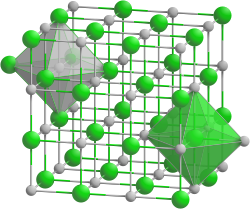Niobium carbide
| Crystal structure | |||||||||||||
|---|---|---|---|---|---|---|---|---|---|---|---|---|---|

|
|||||||||||||
| __ Nb 4+ __ C 4− | |||||||||||||
| General | |||||||||||||
| Surname | Niobium carbide | ||||||||||||
| Ratio formula | NbC | ||||||||||||
| Brief description |
gray odorless solid |
||||||||||||
| External identifiers / databases | |||||||||||||
|
|||||||||||||
| properties | |||||||||||||
| Molar mass | 104.91 g mol −1 | ||||||||||||
| Physical state |
firmly |
||||||||||||
| density |
7.60 g cm −3 |
||||||||||||
| Melting point |
3500 ° C |
||||||||||||
| boiling point |
4300 ° C |
||||||||||||
| solubility |
almost insoluble in water |
||||||||||||
| safety instructions | |||||||||||||
|
|||||||||||||
| MAK |
Switzerland: 5 mg m −3 (measured as inhalable dust ) |
||||||||||||
| As far as possible and customary, SI units are used. Unless otherwise noted, the data given apply to standard conditions . | |||||||||||||
Niobium carbide is an intermetallic compound of niobium and carbon with the empirical formula NbC from the group of carbides . In nature, niobium carbide is very rarely found as the mineral niobocarbide .
presentation
Niobium carbide is produced by reacting niobium with carbon powder in a vacuum or a hydrogen protective atmosphere.
Small amounts of niobium carbide can be obtained from niobium wires at temperatures above 2500 ° C in a hydrogen atmosphere with the addition of small amounts of hydrocarbons (e.g. toluene , methane , acetylene ). Production by reacting niobium oxides and carbon is also possible.
Properties and use
Niobium carbide is an iron-gray to dark-gray powder that, in its compact, sintered state, has a more or less metallic sheen. Due to tarnishing it is sometimes colored on the surface from brown to yellowish. It has a homogeneity range from NbC 0.7 to NbC 0.99 and oxidizes from 800 ° C. It has a cubic crystal structure of the sodium chloride type with the space group Fm 3 m (space group no. 225) . It has a Mohs hardness of 9+, making it a hard material and soluble in a mixture of hydrofluoric acid and nitric acid . With Nb 2 C, another niobium carbide (CAS number 12011-99-3) with a hexagonal crystal structure and a melting temperature of 3080 ° C is known.
use
Niobium carbide is used as an additive to special steels (it increases wear resistance, which means that these steels are used, for example, for piston rings ), for coating graphite for nuclear reactors and as a sputtering material for the production of semiconductor films.
Pure niobium is obtained from niobium carbide and niobium (V) oxide at 2000 ° C.
Individual evidence
- ↑ a b c d e f g data sheet Niobium carbide, 99 +% (metals basis) at AlfaAesar, accessed on June 27, 2013 ( PDF )(JavaScript required) .
- ↑ a b W. M. Haynes, David R. Lide, Thomas J. Bruno: CRC Handbook of Chemistry and Physics 2012–2013 . CRC Press, 2012, ISBN 1-4398-8049-2 , pp. 4–78 ( limited preview in Google Book search).
- ↑ Swiss Accident Insurance Fund (Suva): Limits - Current MAK and BAT values (search for 12069-94-2 or niobium carbide ), accessed on November 2, 2015.
- ↑ Mineral Atlas: Niobocarbide
- ↑ Niobocarbide . In: John W. Anthony, Richard A. Bideaux, Kenneth W. Bladh, Monte C. Nichols (Eds.): Handbook of Mineralogy, Mineralogical Society of America . 2001 ( handbookofmineralogy.org [PDF; 62 kB ; accessed on February 24, 2018]).
- ↑ a b c Georg Brauer (Ed.) U. a .: Handbook of Preparative Inorganic Chemistry. 3rd, revised edition. Volume III, Ferdinand Enke, Stuttgart 1981, ISBN 3-432-87823-0 , p. 1475.
- ^ Hugh O. Pierson: Handbook of Chemical Vapor Deposition, 2nd Edition: Principles, Technology ... William Andrew, 1999, ISBN 0-08-094668-2 , pp. 241 ( limited preview in Google Book search).
- ↑ Roger Blachnik (Ed.): Paperback for chemists and physicists . Volume III: Elements, Inorganic Compounds and Materials, Minerals . founded by Jean d'Ans, Ellen Lax. 4th, revised and revised edition. Springer, Berlin 1998, ISBN 3-540-60035-3 , pp. 632 ( limited preview in Google Book search).
- ^ A b Dale L. Perry: Handbook of Inorganic Compounds, Second Edition . Taylor & Francis, 2011, ISBN 1-4398-1462-7 , pp. 488 ( limited preview in Google Book search).
- ^ Ernst Brunhuber, Stephan Hasse: Giesserei-Lexikon . Fachverlag Schiele & Schoen, 2001, ISBN 3-7949-0655-1 , p. 909 ( limited preview in Google Book search).
- ^ Karl-Heinz Lautenschläger: Pocket book of chemistry . Harri Deutsch Verlag, 2007, ISBN 978-3-8171-1761-1 , pp. 554 ( limited preview in Google Book search).


